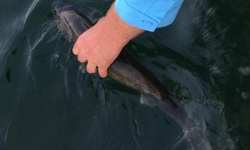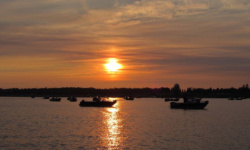by: Ron Hustvedt
It’s beginning to look like spring, but I think my brain is still frozen.
It sure doesn’t look like May out there just yet. I’m no meteorologist, but ice-out still feels two to four weeks behind schedule.
Available data about ice-out dates from the Minnesota DNR (click here for the site) suggest that I’m onto something. Visit this site in late April/early May, and you are likely to acquire an obsessive-compulsive habit of refreshing the page in hopes of seeing that your favorite opening fishing destination has had ice-out.
If luck is on my side once again, I’ll be spending fishing opener with my family on Gull Lake near Brainerd as I’ve done most openers over the last 30 years. Back in 2013, ice-out arrived on May 15, just three days before the record, set May 18, 1950. Will the record fall this year? We’ll see. Most of big Gull Lake was open back in 2013, but there was a large sheet of ice covering about two-thirds of the main lake opening weekend.
That was also the year my cousin, Bryan “Beef” Sathre, and I cruised up to Pike Bay Lake near Cass Lake and walked on the ice just to say that we’d gone ice fishing on the walleye opener. It was crazy but we took proper precautions and had fun.
Whatever the opener brings, it’s a tradition for hundreds of thousands of Minnesotans to take to the water, and that’s what will happen in a lot of places no matter what. Where there is open water, the walleyes likely will be well behind schedule.
Across most lakes in the northern half of the state, walleyes will still be spawning, and finishing the spawn in the southern half. This will make fishing a bit tricky, but the good news is that walleyes will be fairly concentrated in a few choice locations.
Moving water will be key to locating walleyes this year, and that could be an inlet, outlet, or windswept shorelines with rocks or gravel bottoms.
On lakes where those features don’t exist, and on larger lakes, look for the walleyes to hold tight to shallow sandy flats. The best flats are those on the northern or eastern side of the lake where exposure to the sun throughout the day can make water temperatures higher.
There is a high likelihood that some of the larger bodies of water in the northern half of the state will have large sheets of ice. I also suspect that many bodies of water that receive heavy fishing pressure, and also have concentrated spawning areas, will see some closures of areas to fishing because of the spawn. Check with local baitshops, the DNR website, or signs at the boat landing for details.
While you are at the baitshop, grab a scoop of fatheads and restock your supply of small jigs, preferably with those weighing 1/16- to 1/8-ounce. Splurge for a dozen small shiners if they have any and support your locally owned baitshop and bait dealers. It’s a tough business these days, and with the cold water, those shiners will stay alive in the livewell or minnow bucket all day if you keep fresh water flowing.
Using slip-bobbers in shallows immediately adjacent to a channel or right in the deep hole of a channel are great tactics during the mid-day bite. Slowly work over large flats where you know (or can see) vegetation emerging. Baitfish tend to hold on these locations and the walleye are not far behind, with males moving in to feed on lakes where the spawn is wrapping up.
Typically, crankbaits are not the lure of choice during a cold opener, but anglers can expect success in the right conditions. If the sun is high all day and the weather warm, those are the right conditions for a hot evening bite. Cover lots of water by slowly trolling a shallow-running Rapala over those sandy flats or casting a suspending crankbait into the same areas where walleyes are holding.
Those same locations are great for casting slip-bobbers into the evening, including the night bite. A lot of anglers wait out the crowds of fishing-opener morning, instead opting for the evening and night bite, which is usually better than in the morning.
With larger walleyes, practice catch-and-release, especially if there are eggs coming out as you handle the fish. Return those females full of eggs to the lake so they can complete their spawn.






